Soldering of copper pipes: step-by-step analysis of work and practical examples
Home masters try to carry out construction and repair work on their own, which allows not only to save the family budget, but also to be absolutely confident in the quality result. Therefore, they have to master new methods and technologies - such as soldering copper pipes.
We will tell you how to assemble and connect communications from copper pipes. Here you will find out what consumables and tools the performer will need. Useful skills, even in everyday life, will make it possible to independently assemble pipelines with excellent operational characteristics.
The content of the article:
Soldering Copper: Why You Should Learn It
Copper pipelines are rarely used in practice. The reason for this is the rather high cost of materials. However, copper pipelines are rightfully considered the best.
This metal surpasses all other materials in heat resistance, flexibility and durability. Heating copper pipes after assembly, it can be poured into concrete, hidden in walls, etc. During operation, nothing will happen to them.
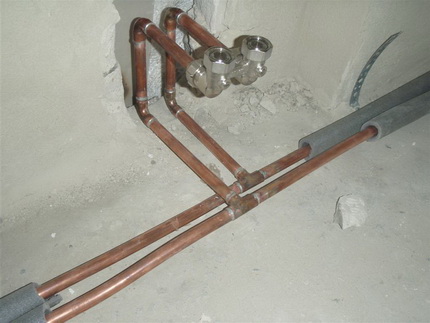
This should be taken into account when choosing a material for arranging heating or water supply. Counting on long-term operation, higher costs are fully recouped. In addition to the excellent performance that copper has, it is quite easy to install. “Scary Tales” about difficulties in soldering are often exaggerated.
Copper is simple enough to solder. Its surface does not require the use of aggressive cleaning agents.Many low-melting metals have high adhesion with it, which simplifies the selection of solder.
Expensive copper fluxes are not needed, since no violent reactions with oxygen occur during metal melting. In the process of soldering, the pipe does not deform, its shape and dimensions remain unchanged. The resulting seam can be unzipped if necessary.
Ways to solder copper parts
Soldering is considered the best method for joining copper parts. During operation, the molten solder fills a small gap between the elements, forming a reliable connection.
Two methods for preparing such compounds are most common. This is a high-temperature and low-temperature capillary soldering. Let's see how they differ from each other.
High Temperature Features
In this case, the process of connecting elements from copper takes place at a temperature exceeding +450 degrees. The solder is selected compounds, the basis of which are fairly refractory metals: silver or copper.
They give a strong seam, resistant to mechanical damage and high temperatures. Such a compound is called solid.
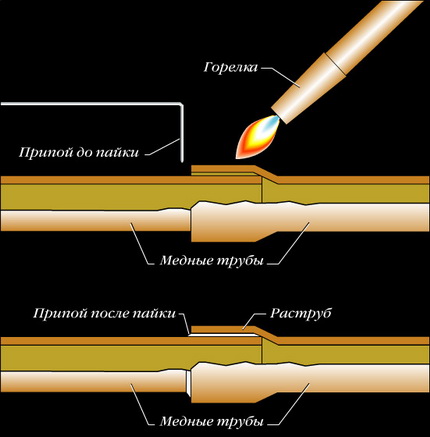
A feature of the so-called solid brazing is the annealing of the metal, this leads to its softening. Therefore, in order to minimize losses in the strength characteristics of copper, it is necessary to cool the finished joint only naturally, without using artificial blowing or lowering the part into cold water.
A solid joint is used for pipes with a diameter of 12 to 159 mm. High temperature brazing is used to connect gas pipes.
In plumbing, it is used in the process of assembling water pipes for a monolithic joining of parts whose diameter exceeds 28 mm. In addition, such a connection is used in cases where the temperature of the fluid circulating in the pipes can exceed +120 degrees.
High temperature soldering is also used for the assembly of heating systems. Its advantage is considered to be the possibility of arranging an outlet from a previously mounted system without its preliminary dismantling.
Low temperature soldering in detail
Soft or low-temperature soldering refers to the connection of copper parts, during which a temperature below + 450 ° C is used. In this case, soft fusible metals, for example, tin or lead, are selected as solder.
The width of the seam formed by such soldering can vary from 7 to 50 mm. The resulting compound is called soft. It is less durable than solid, but it has a number of significant advantages.
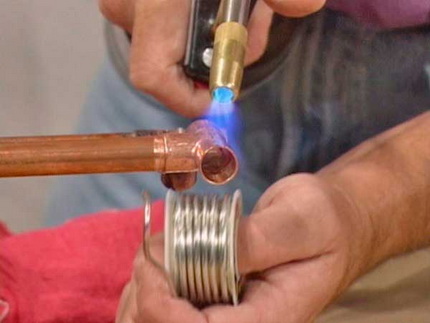
The main difference is that during the soldering process, metal annealing does not occur. Accordingly, its strength remains the same.
In addition, the temperature during the low-temperature brazing is not as high as that during the high-temperature brazing. Therefore, it is considered safer. The so-called soft joints are used to assemble pipes of small diameter: from 6 to 108 mm.
In plumbing low temperature connections copper pipes used for the installation of water mains and heating networks, but provided that the temperature of the liquid circulating in them is less than +130 degrees. For gas pipelines, the use of this type of connection is strictly prohibited.
What is needed in the process?
To make high-quality joints, you will need special materials and tools. First of all, a flux is needed to process the previously cleaned surface of the parts. It removes oxides from the base, improves the spreadability of molten solder and reduces surface tension.
In addition, you will also need solder for working with copper. For high-temperature welding, a material is selected that does not include lead. The packaging should be labeled “lead free” or “lead free”.
For low-temperature soldering, a low-melting solder is selected, in which tin, copper, bismuth, and silver can be present. Solder low temperature type is available in the form of a 3 mm wire.
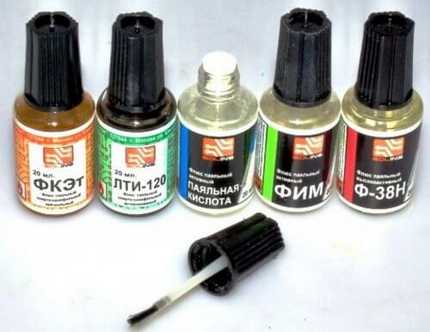
For work, you will need tools. Primarily, pipe cutter. With it, it will be possible to cut the details of the desired size. It is important to choose a high quality tool so that the soft material, which is copper, does not jam.
It also takes a chamfer to remove the burrs. Otherwise, it will be impossible to insert one part into another. To clean the inner surface of the pipes, a brush or brush is also used.
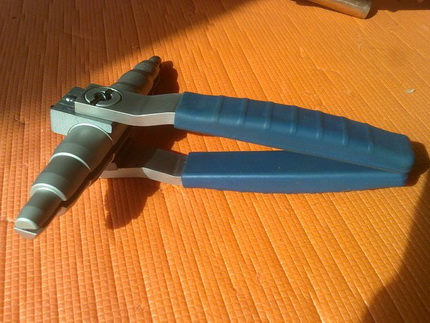
To heat the copper elements using different tools. Most often, for low-temperature soldering choose gas burnerhaving a narrow flame.
The gas equipment in this case works from a cylinder with a mixture of propane and butane or with pure butane. One such refueling is enough for 3-4 hundreds of joints.
The device works efficiently, when heated by the burner, the pipe heats up in a few seconds. High-temperature soldering is carried out using propane-oxygen or acetylene-air gas mixtures.
In addition, soldering can be carried out using a special electric soldering iron, designed to work with parts made of copper. The device is capable of working with both hard and soft solders. The soldering iron is connected to the network and is used where it is impossible to work with open fire. The device is equipped with clamping pliers and removable electrodes.
In addition to these tools for the installation of the pipeline you will need a marker or pencil, tape measure, hammer and construction level.
Brazing Technology
Having prepared the tools and materials, you can begin the soldering process. We perform all operations in the following sequence:
Cut the part of the required length
A variety of tools can be used to cut copper pipes. The most commonly used manual pipe cutter. To make the cut even, we hold the pipe only perpendicular to the tool.
We clamp the part between the roller and the blade and rotate the pipe cutter around it. After each revolution, do not forget to tighten the adjusting bolt by about a third of a revolution. When using a pipe cutter, the cut will be even, scoring will appear only inside the pipe.
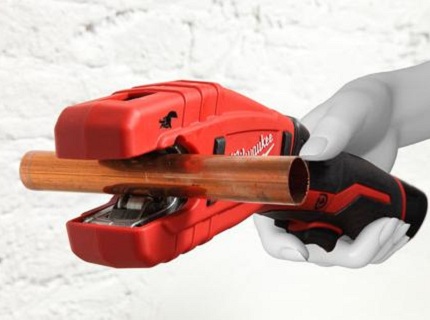
But at the same time, the diameter of the product will slightly decrease, which is undesirable. You can avoid deformation of the part if you cut it with a hacksaw. But in this case, there will be a lot of burrs, which will need to be disposed of, and you will need to use a template to reduce the cut of the cut.
The crushing or ovalization of the pipe cut will lead to unpleasant consequences, since they will necessarily change the size of the mounting gap. Its value should be in the range of 0.02-0.4 mm. If the gap is less, solder will not be able to get into it. With an increase in the gap, the capillary effect cannot manifest itself.
As a result of cutting, a part should be obtained with a strictly cylindrical end with a minimum cut cut. Be sure to remove the burrs from the part, clean its inner surface with a brush and degrease it. Similarly, we trim the second fragment of the pipe. We take a pipe expander and with the help of a hammer we increase the diameter of the second pipe.
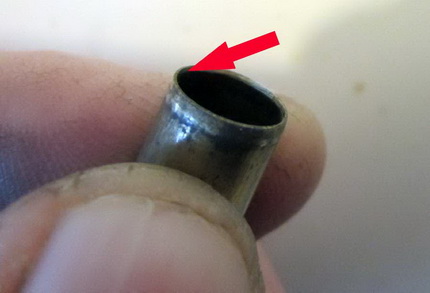
We check how the parts fit into one another, we check the dimensions of the resulting mounting gap. It must exactly match the norm. We clean and degrease the second part. The operation is performed over the entire cross section of the pipe, remember that the length of the connection should be equal to the diameter of the part.
Apply flux to the surface of the pipe
According to the rules of technology soldering copper pipes, apply a flux layer to the parts. We take the composition and with a brush gently apply it to the outer surface of the pipe, which will be inside the connection.
We perform the operation very carefully.We try to collect the minimum amount of solution and completely distribute it over the part. Excess flux should not remain on the surface.
We connect parts before soldering
Once the flux is applied to the parts, they must be connected. This must be done quickly enough so that particles of contamination do not get on a damp surface. If we work with a fitting or with a bell, we make a complete connection of the elements.
To do this, rotate them all the way. In the process of rotation, the parts not only “snap” into place, but also the flux is distributed as evenly as possible across the mounting gap.
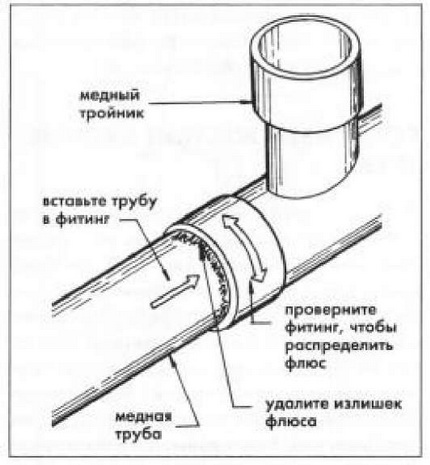
Leaving the flux on the parts is prohibited, since it is an aggressive chemical composition.
Soldering a tap with a fitting based on a compression ring is performed in the following order:
Compound formation at low temperature soldering
When making a soft joint, fusible solder and low-temperature flux are mandatory. For heating, you can take a standard or small gas burner, which is charged with a mixture of propane with air or propane with butane and air. You can take a special electric soldering iron.
We take the burner, turn it on and direct the flame to the pipe joint. The contact spot between the flame and the part must be constantly moved. This is necessary so that the elements are heated evenly. We take solder and from time to time we touch it with the mounting gap. With sufficient heating, the solder begins to melt.
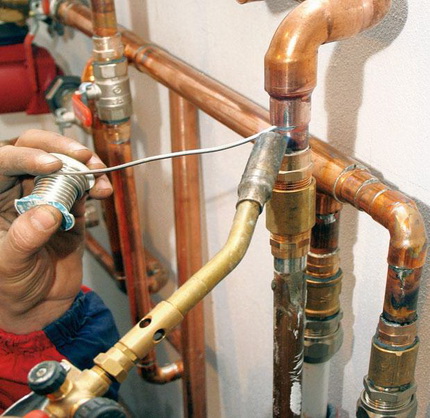
As soon as this happens, we take the burner aside to allow the solder to fill the capillary gap completely. If the solder has not yet begun to melt, continue heating. A feature of low-temperature soldering is that the solder is not specially heated. It should melt from the heat of the heated elements of the compound.
After the solder fills the capillary gap completely, it must be allowed to cool, preferably in natural conditions. It must be remembered that the resulting soft joint has a low strength, so it is forbidden to touch it in hot form.
Another important point. In the process of soldering it is extremely important not to overheat copper. Otherwise, the flux deposited on the metal will collapse, and, accordingly, will not be able to dissolve and remove oxides, which will sharply negatively affect the quality of the compound.
Therefore, it is advisable to use flux with solder powder. When the temperature of the part is sufficient to heat the solder, the powder will melt and it will be seen how droplets of the melt shine inside the flux.
If the use of the flame for any reason is unacceptable, soldering devices powered by electricity are used. Such equipment is a set of a power supply, electric tongs and a soldering iron.
The procedure for heating and subsequent formation of the compound with a soldering iron is no different from the one described above. The only caveat: it can take less time to completely heat up the parts than when heating with a burner.
The formation of a seam when soldering high temperature type
In the process of such soldering, a gas burner is also used to heat up the parts. It is charged with a mixture of propane with oxygen or acetylene with air. It is possible to use a mixture of acetylene-oxygen.
Masters recommend warming up the parts evenly and quickly. That is, the warm-up process should be short. The gas burning in the device should produce a bright blue flame of low intensity.
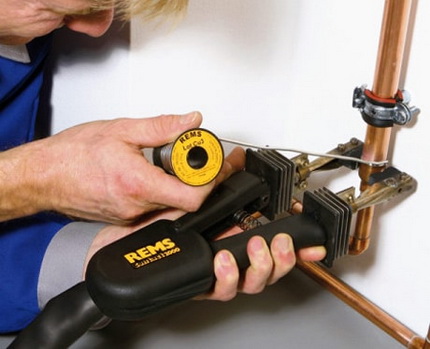
We smoothly move the burner along the future connection so that the heating is as uniform as possible. When copper heats up to about 750C, it will acquire a dark cherry color. At this point, serve the solder.
To make it better warmed up, you can warm it up a bit with a burner. But it must be remembered that the solder should melt from the heated parts of the connection, and not from the burner. Ideally, it is necessary to provide the connection with minimal heating, in which the solder will immediately melt and fill the installation gap the first time.
Perhaps this will not work right away, but as experience accumulates, the result will improve. After the gap is completely filled with solder, leave the connection to cool. Touching it is not recommended at this time. We carefully wipe the cooled seam to get rid of the flux residues.
A detailed analysis of the technology of brazing copper pipelines using a gas burner given in the article, the contents of which we advise you to read.
Copper Tube Safety
Novice masters are interested in how to solder copper pipes correctly, but at the same time forget about safety. This cannot be done. You need to understand that copper is characterized by high thermal conductivity, so you can not hold parts in your hands without any protection.
Carelessness and carelessness with copper pipe assembly may result in a thermal burn. Small items up to 0.3 m in length are taken only with protective gloves or held with pincers.
Caution is also needed when working with flux. This is an extremely aggressive composition. If during soldering it gets on the skin, you should immediately stop work and wash off the flux from the skin with plenty of soapy water. Otherwise, not only a thermal, but also a chemical burn may appear on the skin.
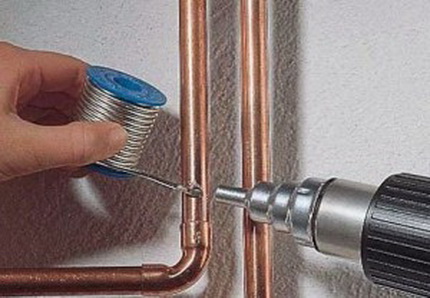
Clothing for work also needs to be selected correctly. Synthetic fabrics are absolutely not suitable. Artificial fiber is very sensitive to high temperatures. It easily melts and lights up, so for work it is best to choose dense clothes made from natural cotton.
Another important point. When parts are heated, the flux begins to burn. His couples are dangerous to humans. For this reason, the room where brazing of copper pipes is being carried out should be well ventilated.
Experienced craftsmen advise those who first started soldering to first practice on pipe trunks. Practice shows that after three or four independently made connections, it is already possible to take up the installation of the pipeline. In this case, it is advisable to assemble the system on the floor and only then proceed with soldering.
The finished pipeline must be rinsed well with clean hot water to remove solder and flux from the inside of the parts.
The main mistakes made when soldering
The process of soldering copper pipes is quite simple, but requires some experience. Beginners often make mistakes in work.
Consider the main ones:
- The presence of defects on the surface of the connected parts.Such flaws may appear in the process of cutting the pipe. If soldering is carried out over the defect, the seam will be fragile.
- Pollution at the junction of elements. Parts must be degreased after cutting and cleaning.
- Insufficient width of mounting gap. According to the rules, for parts with a cross section from 6 to 108 mm, the gap dimensions should be from 7 to 50 mm.
- Inadequate heating of parts. In this case, the solder will not be able to properly fuse with the base. Such a seam will easily collapse even under light load.
- The flux does not cover the entire surface of the pipe. Oxides remain on the surface of the part, which negatively affects the quality of the seam.
- Overheating of the connection section. It leads to the combustion of flux and the formation of oxide and scale. As a result, the quality of the connection deteriorates sharply.
- Check for a cold connection. Before checking the quality of the seam, you need to make sure that the pipe has cooled down. Otherwise, the joint will inevitably deform and lose strength.
- Ignoring security rules. Soldering is carried out at high temperatures and using aggressive chemicals. Protective clothing, mask and gloves are required.
Perhaps it will be difficult for a novice master to independently determine the degree of heating of parts, then it is worth inviting a professional and making the first connections under his guidance.
He will introduce methods of constructing heating circuits from copper pipes next articlewhich we recommend that you familiarize yourself with.
Conclusions and useful video on the topic
You can find out even more interesting information about soldering copper pipes from the following videos.
Video # 1. Features of high temperature brazing of copper:
Video # 2. How to solder copper fittings:
Video # 3. What are soldering fluxes:
Soldering copper pipes yourself is a useful skill that will surely come in handy for a home master. Pipelines made of copper are very long and trouble-free. Given the rather high cost of such parts, self-assembly can significantly save and get a high-quality pipeline at a very reasonable price.
Do you have personal experience in connecting copper pipes by soldering? Perhaps you have knowledge of the nuances of the work? Please write comments in the block below, ask questions, share your opinion and photos on the topic of the article.

 Soldering polypropylene pipes: work rules and analysis of possible errors
Soldering polypropylene pipes: work rules and analysis of possible errors 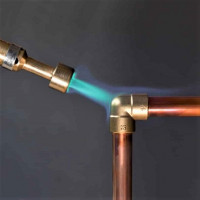 Soldering copper tubes with a gas burner: useful tips and steps for self-soldering
Soldering copper tubes with a gas burner: useful tips and steps for self-soldering 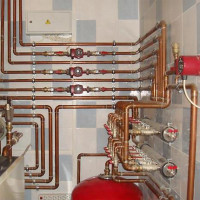 DIY copper pipe installation: copper pipe installation technology
DIY copper pipe installation: copper pipe installation technology 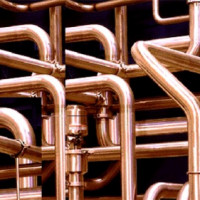 Connecting copper pipes: instructions and comparison of various installation technologies
Connecting copper pipes: instructions and comparison of various installation technologies 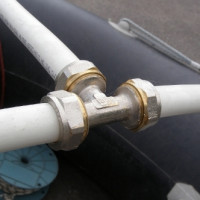 How to crash into a plastic pipe: features of work and analysis of all important nuances
How to crash into a plastic pipe: features of work and analysis of all important nuances 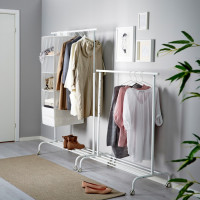 PVC pipe hanger: popular options + step-by-step instruction
PVC pipe hanger: popular options + step-by-step instruction  How much does it cost to connect gas to a private house: the price of organizing gas supply
How much does it cost to connect gas to a private house: the price of organizing gas supply  The best washing machines with dryer: model rating and customer tips
The best washing machines with dryer: model rating and customer tips  What is the color temperature of light and the nuances of choosing the temperature of the lamps to suit your needs
What is the color temperature of light and the nuances of choosing the temperature of the lamps to suit your needs  Replacement of a geyser in an apartment: replacement paperwork + basic norms and requirements
Replacement of a geyser in an apartment: replacement paperwork + basic norms and requirements
I very rarely have to deal with copper pipes, there are really few who use them, preferring cheaper and more utilitarian plastic. But I saw such pipes in houses that claim to be elite. They fit perfectly into the interior. And I also had a chance to solder them. I can say from personal experience that to carry out this work is both uncomplicated and there are nuances.
Copper is a responsive metal; in itself it will not cause you problems. But if you yourself make mistakes, then after some time the place of your soldering will flow. To everyone who suddenly encounters the need to solder a copper pipe, first of all I will say - do not be lazy and do not spare time for preparatory work! A good start is half the battle.
Badly degrease - it will flow. Stripping badly is the same. Second: moderate but sufficient flux. You will regret it will flow. Overdo it - get an ugly spot of adhesions.Third: competent temperature conditions. Both overheating and underheating are equally bad. In general, if you are going to solder for the first time, then it is best to find somewhere a piece of a copper pipe and practice, as in a draft. At the same time, identify your possible mistakes.